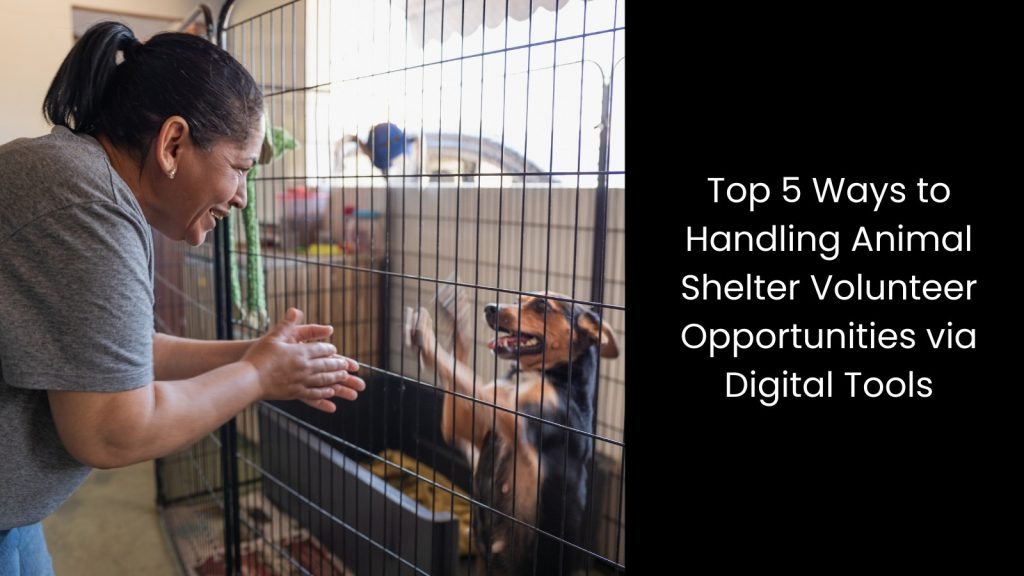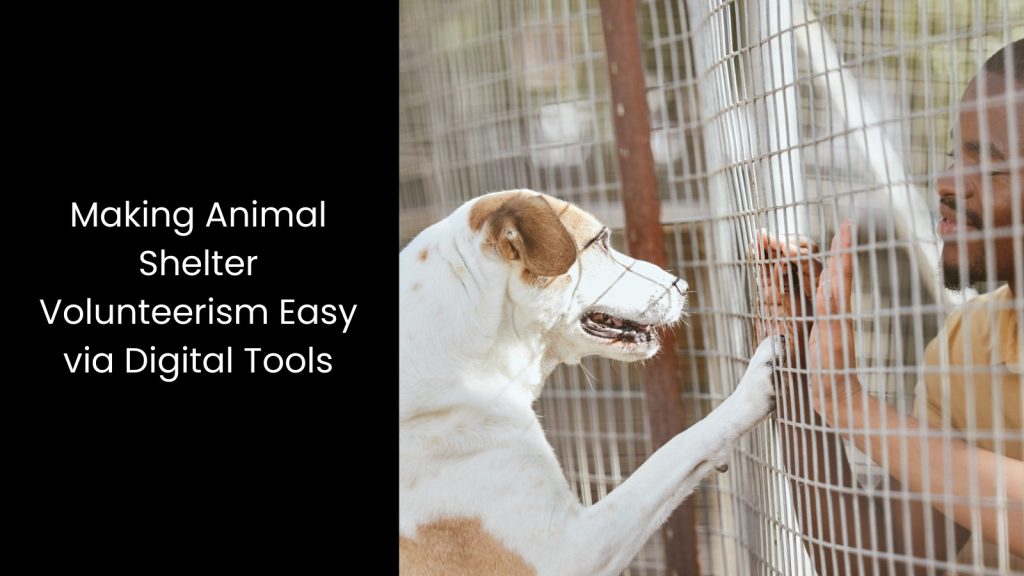Have you ever wanted to make a difference in the lives of countless animals or need help but found it difficult to navigate through traditional volunteering boundaries? In the digital age we have entered, there is certainly a growing trend of utilising technology to streamline volunteer programs. Singapore has come a long way in this, and it started using robust digital tools to make it easier for people to contribute to their cause.
This article explores how digital tools are revolutionising the way animal shelters manage volunteer opportunities in the Singaporean landscape.
We will know
What is Volunteerism in an Animal Shelter Environment?

Before going further, let us explain what animal shelter volunteerism is.
- Volunteerism in an animal shelter environment in Singapore involves individuals dedicating their time, skills, and energy to support the welfare of animals in need.
- You know, when it comes to Singapore, animal shelters face challenges such as limited resources and space, making volunteer contributions a most required aspect. Volunteers perform a range of tasks, including feeding, cleaning, exercising the animals, and assisting with adoption events. They also play a key role in raising awareness about animal welfare and helping to educate the public about responsible pet ownership.
- Currently, Singapore has around 10 to 15 animal shelters, including well-known ones like the Society for the Prevention of Cruelty to Animals (SPCA), Action for Singapore Dogs (ASD), and Cat Welfare Society (CWS). These shelters rely heavily on volunteers to maintain daily operations and ensure the animals receive the care and attention they need.
- Given Singapore’s urban landscape and strict regulations on pet ownership, many animals, particularly abandoned pets, end up in shelters. This is where volunteerism helps address this issue by providing hands-on support to shelters and promoting responsible pet practices. In this environment, volunteerism goes beyond basic care; it involves creating a community of individuals passionate about animal welfare.
Top 5 Ways to Handling Animal Shelter Volunteer Opportunities via Digital Tools

Online Volunteer Management Portals
One of the major ways that technology significantly improves the handling of animal shelter volunteer opportunities is by providing online volunteer management portals that simplify and streamline the process. Let us explain how this actually works.
These portals centralise all volunteer-related activities, making it easier for shelters to manage their volunteer programs effectively. In Singapore, charity organisations tend to use such platforms to manage volunteer schedules, track hours, and communicate with volunteers. These platforms streamline coordination and reduce administrative workload.
Since they allow volunteers to view and sign up for shifts online, these portals eliminate the need for manual scheduling. Not to mention that it reduces the chances of miscommunication or double bookings. They also provide a clear overview of volunteer availability, helping shelters plan and allocate tasks more efficiently.
In one way, it encourages tracking hours digitally, and this certain capacity ensures accurate record-keeping, which is essential for recognising volunteers’ contributions and for reporting purposes.
Furthermore, these platforms often include training modules, allowing shelters to provide necessary training materials and instructions online. This feature ensures that volunteers are well-prepared and understand the shelter’s protocols before they start their shifts.
Mobile Apps for Remote Monitoring
Singapore is a place where the use of mobile apps has conquered the digital realm. Animal shelter volunteerism cannot simply stay away from this trend.
Due to the expansion of technology, more and more charity organisations that work for animal welfare have started opting for mobile apps nowadays. The latter makes it easier to oversee activities even when volunteers and coordinators are not on-site.
These apps allow shelters to track tasks and animal care in real time, ensuring that every animal receives the attention it needs. For example, mobile apps can provide a checklist of daily tasks, such as feeding, cleaning, and exercise routines, which volunteers can update as they complete each duty. This real-time monitoring ensures that shelter coordinators always know which tasks have been done and what still needs attention, reducing the risk of any animal being overlooked.
Another thing is that mobile apps facilitate better communication between volunteers and shelter staff. As you can see, volunteers in Singapore can use these apps to report any issues or concerns, such as an animal showing signs of illness, immediately alerting staff members who may not be on-site. This quick response capability improves the overall care of the animals and can sometimes be lifesaving.
These apps also enhance scheduling by allowing volunteers to view available shifts and sign up for them directly from their smartphones. They receive instant notifications about their schedules, upcoming shifts, or changes, making it easier to manage their commitments.
Virtual Volunteering Opportunities
Who says charity work is limited to geological boundaries?
Now cutting-edge technology transforms animal shelter volunteer opportunities as it offers virtual volunteering options. The actual benefit of this is that it allows individuals to contribute without being physically present at the shelter. This approach expands the volunteer base, as people who have busy schedules or live far away can still support animal welfare.
If you wonder what these virtual volunteering opportunities are, they include activities such as helping with administrative tasks, managing social media accounts, creating promotional content, and assisting with fundraising campaigns. For example, a volunteer can design flyers, write blog posts, or run social media pages to raise awareness about the shelter’s needs and the animals up for adoption. This remote support increases the shelter’s visibility and encourages more community involvement.
Apart from this, virtual volunteers can participate in organising online fundraising events, such as virtual pet adoption drives, webinars, or charity auctions. They can use platforms like Zoom or social media live streams to engage with potential adopters and donors, creating more opportunities for the shelter to gather resources and find homes for the animals.
So, as it is evident, animal shelter volunteerism does not have barriers at all.
Automated Communication Systems
One of the most common challenges in communication within animal shelter volunteering is keeping everyone informed and coordinated. Do you agree?
With multiple volunteers working different shifts, it becomes difficult to relay updates, schedule changes, or urgent needs effectively. Miscommunication can lead to issues like overlapping shifts, missed tasks, or volunteers not knowing important shelter protocols.
However, the good thing is that modern technology addresses these challenges by offering automated communication systems that streamline how shelters interact with their volunteers. These systems use tools like automated emails, text messaging, and app notifications to ensure that volunteers receive timely and accurate information.
For example, shelters can use automated emails to send out shift reminders, announcements about upcoming events, or changes in shelter policies. These messages can be scheduled in advance, reducing the workload for coordinators and ensuring consistency in communication.
Another fact is that automated text messaging can quickly reach volunteers in urgent situations, such as when extra help is needed for an emergency intake of animals. Did you know that some shelters use apps or platforms that send real-time notifications directly to volunteers’ smartphones? It keeps them updated on any immediate needs or schedule changes.
These automated systems also allow for two-way communication. Volunteers can use the same platforms to confirm their shifts, ask questions, or report issues, all of which get directed to the appropriate staff members without delay. This level of communication helps build a more responsive and engaged volunteer community.
Virtual Orientation and Training
We explained how technology overcomes geographical barriers in the modern age, allowing people to participate in activities regardless of their location. This capability proves especially helpful for animal shelters, where volunteers may live far away or have limited availability.
When a charity organisation opts for virtual orientation and training via digital tools, it helps boost the engagement of these volunteers without requiring them to visit the shelter in person. As it offers virtual training, shelters can provide consistent and comprehensive preparation for all volunteers, ensuring they understand their roles and the shelter’s procedures.
Virtual orientation programs usually have a large variety ranging from videos, online modules, and interactive guides that cover essential topics like animal handling, shelter protocols, safety measures, and emergency procedures. Volunteers can access this training from anywhere, at any time, making it easier for people with different schedules and time zones to participate.
This flexibility attracts a broader range of volunteers, including those who might otherwise be unable to commit due to location or time constraints. Virtual training also ensures that every volunteer receives the same information, reducing the chances of miscommunication or varying levels of preparedness.
In a way, this can be called ‘flexibility,’ and in another way, this is certainly ‘standardisation’ which leads to more efficient and safer shelter operations, as all volunteers know exactly what is expected of them.
Making Animal Shelter Volunteerism Easy via Digital Tools

There is no doubt that digital tools of modern technology make volunteering at animal shelters super easy and efficient. From remote monitoring to virtual orientations, digital tools bridge gaps, allowing shelters in Singapore to focus more on animal care. This is where you require a robust volunteer management tool from a reputed software partner. Don’t you think so?

